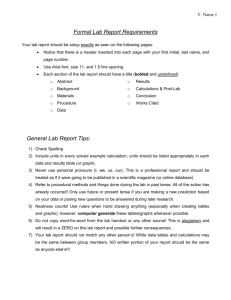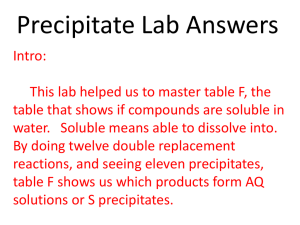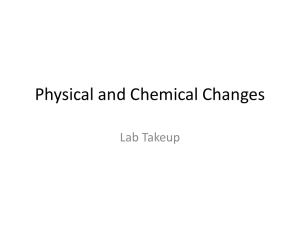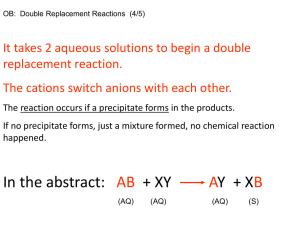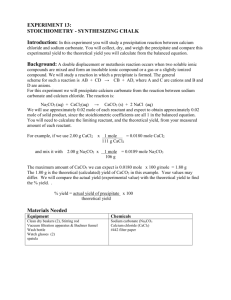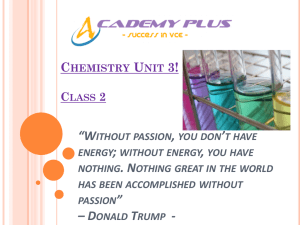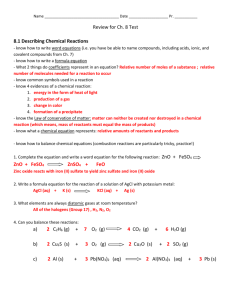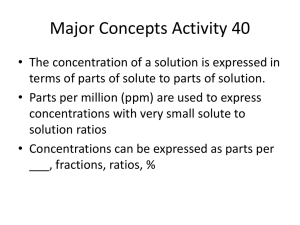CHEM 2 LAB REPORTS
advertisement
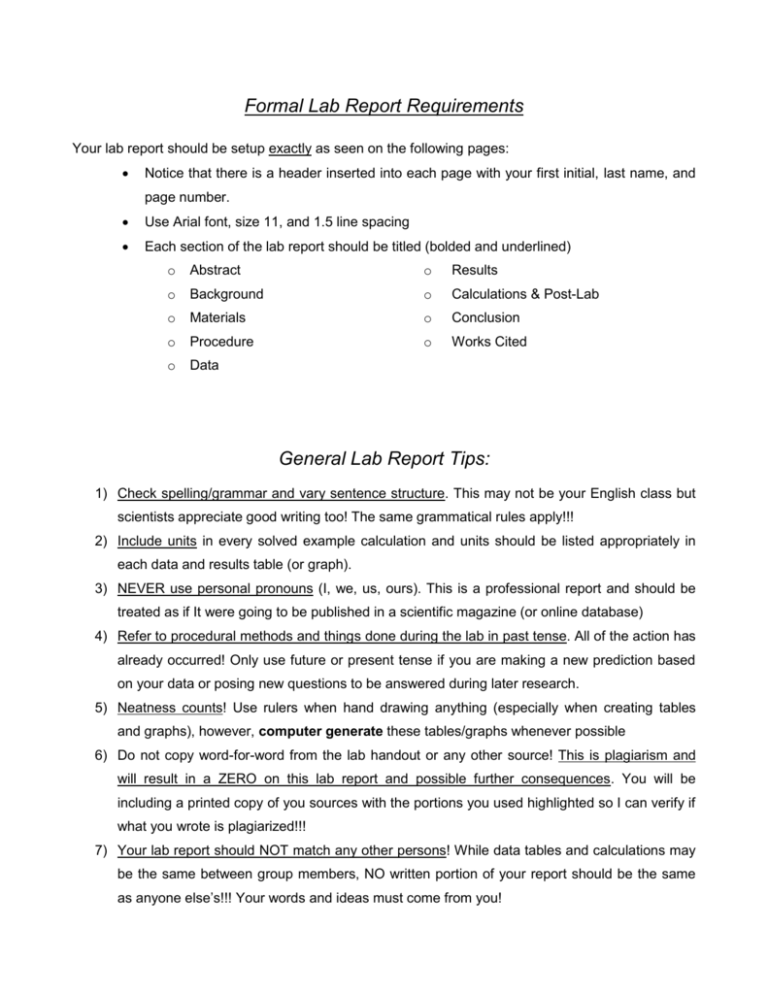
Formal Lab Report Requirements Your lab report should be setup exactly as seen on the following pages: Notice that there is a header inserted into each page with your first initial, last name, and page number. Use Arial font, size 11, and 1.5 line spacing Each section of the lab report should be titled (bolded and underlined) o Abstract o Results o Background o Calculations & Post-Lab o Materials o Conclusion o Procedure o Works Cited o Data General Lab Report Tips: 1) Check spelling/grammar and vary sentence structure. This may not be your English class but scientists appreciate good writing too! The same grammatical rules apply!!! 2) Include units in every solved example calculation and units should be listed appropriately in each data and results table (or graph). 3) NEVER use personal pronouns (I, we, us, ours). This is a professional report and should be treated as if It were going to be published in a scientific magazine (or online database) 4) Refer to procedural methods and things done during the lab in past tense. All of the action has already occurred! Only use future or present tense if you are making a new prediction based on your data or posing new questions to be answered during later research. 5) Neatness counts! Use rulers when hand drawing anything (especially when creating tables and graphs), however, computer generate these tables/graphs whenever possible 6) Do not copy word-for-word from the lab handout or any other source! This is plagiarism and will result in a ZERO on this lab report and possible further consequences. You will be including a printed copy of you sources with the portions you used highlighted so I can verify if what you wrote is plagiarized!!! 7) Your lab report should NOT match any other persons! While data tables and calculations may be the same between group members, NO written portion of your report should be the same as anyone else’s!!! Your words and ideas must come from you! Y. Name 1 Honors Chemistry Mrs. Klingaman – Mods 1-3 North Hunterdon High School Your Name Partner(s): Larry Laboratory, Tara Testtube, Barbara Beaker, and Henry Hotplate Title of Lab Experiment Date Experiment was performed Abstract: An abstract is a paragraph (7+ sentences) that summarizes the completed experiment. In the scientific world, the abstract gives enough information to the reader so that he/she can determine what types of equipment and theories used during the experiment that will be discussed in the report. You should summarize, briefly, what was performed, and what the results were (think of it like the “spark notes” version of your lab report) These are the four main components of an abstract, which should be formed into an organized, well written paragraph: 1) Purpose/Motivation: What are you attempting to do in this lab? Ex) The intended goal of this experiment was to produce and separate calcium carbonate through a precipitation reaction. This precipitate was then be mass and percent yield was determined 2) Procedure/Methods: What scientific process did you actually do to get your results? Be brief about your description (you will explain it in more detail in a later section) Ex) The lab involved the formation of a precipitate through a double replacement reaction of two aqueous solutions. The precipitate was then separated via gravity filtration, rinsed, and massed. 3) Results/Findings: After completing the experiment and analyzing the data, what were the major results? Ex) Upon the completion of three trials, the percent yield of calcium carbonate produced was 93.75%, 94.35%, and 95.62% respectively. . 4) Conclusion/implications: What are the larger implications of your findings as they relate to your purpose? (this is easier to write at the very end after writing the actual conclusion) . Ex) The results of this experiment suggest that filtration is a fairly successful way to separate a precipitate from solution. Furthermore, it is necessary to calculate the theoretical yield of a product based on the stoichiometric quantity of the limiting reactant. This way, the actual yield products can be directly compared for the determination of percent yield. Y. Name 2 Background: The background is between 2-3 full paragraphs (depending on the detail of underlying principles used). Briefly develop the underlying principles or theory which is crucial to this experiment. Any important equations or reactions utilized in this experiment should be included, labeled, and briefly explained in this section of the report. This section may explain why a certain procedure/method/technique was utilized and how it will achieve the desire result. It may also explain how an out-of-the-norm instrument works (like how a spectrophotometer reads wavelengths of light to differentiate molarities based on absorbance). This section of the lab report must include at least one reliable, academic OUTSIDE source of research BESIDES your textbook and/or the written experiment. Any online/web sources that you use in your report must be printed out and attached to the end of the report for your instructor to review. Also, the portions that you paraphrased or quoted must be highlighted or underlined. Ex) In this experiment, a double replacement reaction between calcium nitrate [Ca(NO3)2] and sodium carbonate [Na2CO3] was performed, resulting in the formation of the solid precipitate, calcium carbonate [CaCO3] according to equation 1 below: Ca(NO3)2 (aq) + Na2CO3 (aq) CaCO3 (s) + 2 NaNO3 (aq) Reaction 1 This type of reaction is commonly referred to as a “precipitation reaction”. A precipitate is formed when a cation and anion, from aqueous solutions, ionically bond together and form a new, insoluble compound known as a precipitate (“Precipitation”). The term insoluble means that a substance cannot be dissolved in the given solvent, most typically water. While filtration can be used for different reasons, this lab utilizes the method of gravity filtration in order to separate and collect the solid precipitate produced for massing and analysis (“Filtration”). In the case of this particular experiment, the precipitate was separated from an aqueous solution of sodium nitrate [NaNO3] which was also produced as a byproduct of the reaction. Filtration can either be based on differences in particle size or state of matter; here, the difference in states of matter between the two products of Reaction 1 allows the separation of solution and precipitate. Upon massing the precipitate, the percent yield can be determined according to equation 1 below: Actual yield Theoretical yield x 100 Equation 1 The actual yield is the measured mass of the precipitate produced in the experiment. The theoretical yield is the maximum calculated mass of the precipitate that could be produced given the origin starting quantities of each reactant. In order to determine this theoretical mass, the limiting reactant must be determined and the stoichiometric molar ratio (using Reaction 1) between the limiting reactant and precipitate must be applied to the calculation. … this would continue on Y. Name 3 Materials: List all equipment, chemicals, or other materials used (in bullet form). If chemicals are used, they should be listed by the chemical formula, name. If approximate masses used are known they should be included. Solutions used with known molarities should always be included. Ex) 1.0 M Ca(NO3)2, Calcium Nitrate Glass stirring rod 1.0 M Na2CO3, Sodium Carbonate Filter paper Deionized water Ring stand Test tube Iron ring Test tube holder Funnel Test tube rack Balance Thin stem pipettes Procedure: Briefly describe, in a short paragraph, how the experiment was performed and what MAJOR equipment was used. Do NOT give a step-by-step account of when to pour solution A into solution B or “first, put on goggles. Next, place 2.5 grams of…”, etc. You are giving an overview of what occurred so that another trained scientist could repeat your experiment with the same basic principles in mind. Ex) Solutions of 1.0 M calcium nitrate and 1.0 M sodium carbonate were prepared. Equal volumes of each reactant were combined in an open test tube and stirred to ensure thorough mixing. A solid white precipitate of calcium carbonate and an aqueous solution of sodium nitrate were created as described by Reaction 1. A basic gravity filtration system was setup using a funnel and ring stand. The contents of the test tube were then filtered and rinsed with deionized water in order to ensure separation of the precipitate from the aqueous solution. Upon drying, the mass of the precipitate was measured. Two more trials of the experiment were then preformed. Data: All data and measurements taken in the lab should be arranged into a data table and placed into this section of the report. Often, you can set it up to match the data table given in your lab experiment. Make sure that every table has a title and that every portion of the table is labeled with the measurement and units. Whenever possible, make sure that the data table does not end up split between two pages (even if this means that the data section must start on a separate page) Y. Name 4 Ex) Data and Measurements Table: Ca(NO3)2 and Na2CO3 Precipitation Reaction Trial 1 Trial 2 Trial 3 Mass of Ca(NO3)2 (g) 2.32 2.10 2.25 Mass of Na2CO3 (g) 2.06 2.11 2.09 Mass of filter paper (g) 13.09 13.20 12.99 Mass of filter paper + precipitate (g) 15.41 14.37 14.30 Results: Produce a results table that gives the final calculated answers for all the calculations that the lab asks for performed during/after the lab. This table puts all the important calculations in one concise location and it should be very organized. Make sure that every table has a title and that every portion of the table is labeled with the measurement and units. Whenever possible, make sure that the table does not end up split between two pages (even if this means that the results section must start on a separate page). The results section should NOT include an ounce of calculations within it, only final result values. Ex) Results Table: Ca(NO3)2 and Na2CO3 Precipitation Reaction Trial 1 Trial 2 Trial 3 1 Actual mass of precipitate (g) 1.35 1.17 1.31 2 Theoretical mass of precipitate (g) 1.44 1.24 1.37 3 Percent yield (%) 93.75 94.35 95.62 Calculations & Post-Lab: This section will NEATLY demonstrate the calculation work and set-ups including all the data numbers used and appropriate units. You may type the calculations directly into the lab report, or, if you choose, calculations may instead be hand written but they must be neatly written in INK, not pencil! If anything is hand handwritten/drawn, use a clean sheet of computer paper and attach it directly after the results section, then begin the post-lab section on a new page. Show ONE sample calculation for each type of calculation that is necessary. For example, you would show work for how each calculation was performed, but for ONE trial only (the assumption is that you did the calculations for all trials exactly the same so one sample is enough to determine if it was calculated correctly or not). Typically, the trial with the best results is the one chosen for showing sample work. In the example above, trial 3 would be selected because the % yield is the highest. Be sure to include a title addressing which trial is detailed in the sample calculations. Y. Name 5 For any post-lab QUESTIONS which are not direct calculations, re-type and number the post-lab questions and then answer them in complete sentences. If the post-lab requires any graphs they may be inserted directly into this section or, if hand drawn (in ink) they are to be attached directly before the conclusion section of the lab report. Ex) Sample Calculations: Trial 3 1) Actual Mass of Precipitate: 14.30 g – 12.99 g = 1.31 g CaCO3 2) Theoretical Mass of Precipitate: LR 2.25 g Ca(NO3)2 ER 2.09 g Na2CO3 1 mol Ca(NO3)2 164 g Ca(NO3)2 1 mol Na2CO3 106 g Na2CO3 1 mol CaCO3 1 mol Ca(NO3)2 1 mol CaCO3 1 mol Na2CO3 100.1 g CaCO3 = 1.37 g 1 mol CaCO3 CaCO3 100.1 g CaCO3 1 mol CaCO3 = 1.97 g CaCO3 3) Percent Yield: 1.31 g CaCO3 x 100 = 1.37 g CaCO3 95.62% 4) Explain why an insoluble compound does not dissolve in the presence of a particular solvent. An insoluble compound will not dissolve in the presents of a particular solvent because the forces of attraction that form between the atoms of the compound (whether ionic or covalent) are too great. This means that the attractive forces between the solvent and compound are not strong enough to overcome the forces holding together the compound, thus is insoluble in that particular solvent. Y. Name 6 Conclusion: This should be 1-2 full paragraphs. A great deal of attention is focused on your ability to write a sophisticated analysis of the lab. It should be a unified summary of your work on the topic under study. It should not be brief, fragmentary, expansive, or excessively critical of apparatus or equipment. Write the conclusion soon after completing it, and edit it a day or two later. The conclusion should include the following: 1) Success of lab based on accuracy and precision of results: Compare the results to class averages (if known), evaluate percent error or percent yield values. This is the section for commenting on the SUCCESS of achieving the designated purpose/goal of this experiment based on the data/results evidence. You should include numbers from the results section to support this evaluation Ex) Upon completing three trial of this experiment, the average percent yield of the precipitate, calcium carbonate, was 94.57%. All three trials were fairly precise, with less than a 2% difference in the percent yield between them. Additionally, in comparison to the theoretical yields, the actual quantities of precipitate recovered during the experiment are all within one tenth (0.1) of a gram for every trial. This analysis supports the fact that this experiment was very successful: the results were both accurate and precise. 2) Errors and Explanation: Every lab has got them, what were they? How did they impact your results? Be specific… don’t say, “Not heating the solid long enough caused a great deal of error” instead say, “By not heating the solid long enough, some of the mass accounted for did not chemically decompose. This, in turn, results in less oxygen gas being produced increasing the percent error. Ex) One significant error in this experiment was that some of the aqueous sodium nitrate produced was most likely stuck inside the calcium carbonate precipitate. Although the sample was rinsed with distilled water, it is very likely that the massed precipitate was not 100% calcium carbonate. Additionally, another error found was that, when massed, the precipitate was not fully dry. This means that the mass of the precipitate was inflated, not only due to impurity, but also due to the weight of the non-evaporated water. Both of these errors suggest that the true percent yield for each trial is most likely lower than the calculated percentages due to the fact that sample was impure and not fully dried. Finally, in trial 1, some of the precipitate produced was stuck to the stirring rod and was therefore not included in the mass. This would mean that the true percent yield of trial 1 should be higher than what is reflected. 3) How to Improve: What could be done to increase the accuracy and the precision (assume that you have as much time (and possibly money!) as you need to accomplish this. Include any part of this lab that did not work out well and be sure to give an alternative that may work better. Could you try a different method? Different equipment? A better chemical reaction? Different masses? etc… Ex) While this lab was very successful, there are a few changes which could help to improve both the quantity of calcium carbonate recovered as well as its purity. For example, when massing the filter paper and precipitate, it would be beneficial to dry the sample in a chemical oven to make sure no water is left behind to increase the measured mass. Also, instead of using gravity filtration, it may help to separate the precipitate and solution if suction filtration is used. This would require access to a vacuum but it would increase the speed at which the filtration occurs. Finally, increasing the number of times that the precipitate is rinsed clean with distilled water will help reduce the amount of sodium nitrate trapped within the calcium carbonate. This will significantly improve the purity of the precipitate. Y. Name 7 Work Cited: Include all outside SCHOLARLY references you used in the lab report including your text book (if you used it for reference anywhere in the lab report …FYI: your textbook does not count as your required outside source). This should be written the way your English teachers have shown you, according to MLA format. The website http://owl.english.purdue.edu/owl/resource/747/01/ may be useful if you have questions about MLA. Additionally, the media specialists would be able to help you find appropriate references and/or write works cited. Ex) "Precipitation Reactions." University of Memphis. Department of Chemistry, n.d. Web. 13 Feb. 2014. <http://www.chem.memphis.edu/bridson/FundChem/T17a1100.htm> “Filtration.” University of Arizona. Department of Chemistry. n.d. Web. 16 Feb. 2014. http://quiz2.chem.arizona.edu/vip/filtration/

